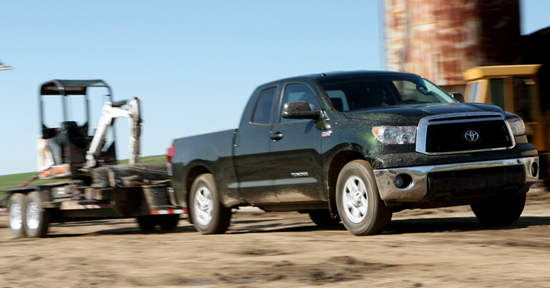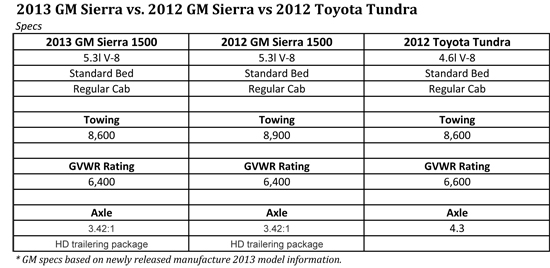GM Drops Tow Ratings Down 4,800lbs – How Does Toyota Tundra Compare?
Tim Esterdahl | Jun 06, 2012 | Comments 18
For years, GM truck buyers have used tow ratings that are now being revised down as much as 4,800 lbs on some models. This is due to a new SAE standard that Toyota has used for years. Now that we are finally able to compare apples to apples, how does the Toyota Tundra compare to the Sierra/Silverado?

GM tow ratings revised, how does the Toyota Tundra stack up?
Starting in new 2013 GM/Chevy trucks, the tow ratings will be based on a new SAE system according to a PickupTrucks.com post. This has caused several models of trucks to have “revised” ratings. Standing out in this revision is a four-wheel-drive Extended Cab long bed with the diesel and a 3.73:1 axle. Its 2012 rating was 15,700 pounds, it is now 10,900 pounds (4,800 lbs lower.) While Ford and Chyrsler will be soon to follow, Toyota already uses this standard starting with the 2011 Toyota Tundra. A big question, we had is how does the 2012 Toyota Tundra now stack up to a 2013 GM Sierra 1500 (whose tow rating has dropped 300lbs since last year)?

As the chart shows, the Toyota Tundra with a smaller motor now tows the same as a comparable Sierra thanks to the new, fair SAE standard.
Tow Ratings Explained
Tow ratings have been an ongoing source of conversation and controversy. Without a true standard, automakers could develop their own rating system. These systems were flawed from the start with many “tests” being performed with an empty pickup and a 150-lb driver. The assumption that you would say tow your boat to the lake with a full-size truck that only had the driver in it, is absurd. It would most likely be filled with supplies and the truck would probably be full of passengers. This meant that the driver needed to take the additional cargo/passenger weight and subtract it against the truck’s towing capacity to determine the true towing rating. Often times, drivers didn’t do this. This is why you would often see an amazing amount of cargo towing a large load in a not so big truck.
A few years ago, SAE engineers, trailer manufacturers and towing dynamics got together to develop a new standard. They eventually settled on a tow-vehicle performance requirement (J2807 standard). There are dozens of tests and measurements included in this standard, but here are the three that will really impact tow ratings and consumers. The following quote is from some sales materials sent to Toyota dealers:
- The new standard says that the max tow rating must take into account the average weight of passengers and accessories. This is likely to reduce tow ratings across the board by 300 to 500 lbs (give or take).
- Each half-ton will be required to complete a 40 to 60 mph passing maneuver in 18 seconds or less at their maximum trailer rating.
- Each truck will need to meet some handling and trailer control standards, most of which will probably result in better quality OEM hitches being included in tow packages.
“In addition to the performance requirements, SAE J2807 applies a standard conservative approach to calculating the trailer mass, which includes two occupants, optional equipment, aftermarket trailer hitch equipment and trailer mass on the vehicle,” said Dean Perelli, chief engineer for GM trucks, as quoted by PickupTrucks.com.
What do you think? If all the manufactures start using the new SAE standards in 2013, will Toyota sell a lot more Tundra pickups?
Related Posts:
Filed Under: Auto News


The latest story is the GM 1500’s got a higher SAE tow rating than Tundra but they won’t be using it they will stick with their own.
I would be interested in seeing this story. Any links to this??????????
The 5.7L Tundra RC has a 10,400lb max towing GM 6.2L EXT Cab has a 10,500lb tow rating http://news.pickuptrucks.com/2.....ckups.html.
GM waits on Ford before adopting standards http://news.pickuptrucks.com/2.....j2807.html
Tundra HQ can you guys do a story comparing Tundra’s tow package to Ford’s Trailer Tow Package, Max Trailer Tow Package and HEAVY-DUTY PAYLOAD PACKAGE. Also add GM’s Heavy duty trailering equip, Trailering Package and Max Trailering Package. I think those things play a big part in tow ratings and why certain model Tundra’s lost more towing than GM.I could be called a tundra fan but I don’t think it is because of the 5.7L iforce, 4.30 axle ratio, 6-speed auto, The ofter blamed to much frame or leaf springs. I don’t think it’s one of the last 2 after Tundra deconstructed.
I should state that I believe we are sending out standard tow package up against their max tow or trailering package and HD payload and tow packages for their 1/2 tons. I can’t believe that the 2 biggest selling light duty pickup makers would have all those different tow packages if they didn’t make a difference.
Thanks for the link. GM using a 6.2L to gain only 100lbs over a 5.7L Toyota does not impress me, LOL.
No, toyota will not sell more tundras because of a mere few hundred lbs. difference in towing. Not a big deal, but the chart indicated 4.6L with a 4.30 rear axle ratio and I think it is std. 3.90 and with tow pkg. 4.10, not 4.30 like on the 5.7L engine. What gets me is the very shameful and wimpy chevy 5.3L still using the 3.42 which is totally a joke in towing anything at all let alone the chevy silverado’s own weight. Anything less than 3.73 rear axle ratio does NOT increase mpg in ‘real’ world driving. Trust me, I know. I have had chevy 5.3L in 3.42, 3.73, and 4.10 rear axle ratios several of them in the past 15 years or so and the best mpg in ‘real’ world driving was with the very rare 4.10 rear axle ratio since it did not ever hardly kick in and out of gear flooring the engine on hills. The 3.42 axle ratio I sold in 6 months hated it to drive, was a wimpy axle ratio for such a heavy truck.
That 3.42 rear is how GM gets the big HWY fuel economy rating…if they put a 3.73 in, the fuel economy rating looks a lot more like everyone else’s.
My guess is that Ford’s ratings are astronomically high, and that Ford knows they’ll take a beating in the press if/when they acknowledge their internal tow rating system is misleading.
Too bad SAE can’t force all the manufacturers to adhere…
No because no other brand will use SAE for 2013, maybe 2013 calendar year.
GM took back their revised ratings and will stick with the old. Ford will wait for the new model. Ram is yet to be determined but does anybody care what they do?
Good point, LOL!
buy axle ratio you need. 308 is for light weights and will shift gear more often than 373 or 410 which are for pulling or drag racing. most people can get by with 308 342 with engine torque over 350ftp and tow very little.
I test drove a Silverado Hybrid with a 3.08 axle, it felt sluggish.
Do you think we’re all stupid? Some may be, I’m not. Your note at the bottom of the table states that, “the Toyota Tundra with a smaller motor now tows the same weight as a comparable Sierra”. Why don’t you go to an even higher rear axle ratio and you can make your tow numbers even bigger. Figures don’t lie but liars figure!
Don,
Huh? The axle listed is Toyota’s STANDARD towing package. I was simply comparing the HD package from GM with Toyota’s towing package. Apples to Apples you know.
-Tim
That’s my point Tim. Unless both vehicles have the same axle ratio, you don’t have “apples to apples”. Put a 3.42:1 in that Tundra and watch the tow weight drop.
Don,
What I am saying is that I am comparing towing packages. Throwing a small rear axle into the Tundra isn’t comparing the stock towing packages that come from the manufactures.
Besides, the 4.6L doesn’t come with that axle ratio from the factory. It only comes with a 4.1 and a 3.9. So, I can’t do your comparison, it simply isn’t possible.
(edit: I do see my chart has a mistake in that it says 4.3 axle. The 4.6L doesn’t come with a 4.3 rather it comes with a 4.1. The towing number is correct, I just double checked.)
-Tim
I understand you’re comparing towing packages, but your table comparisons are misleading. Yeah, your Tundra can pull as much as the others with a smaller engine, but at what expense to other important performance parameters like acceleration, cruise speed, gas mileage, etc. And I think it’s unprofessional to berate your competition and accuse them of lying, but that’s what marketing is all about! You’re not fooling me though.
Don,
What is cruise speed? The only time I hear that term applied is usually to aircraft.
As far as gas mileage is concerned, that is not the point of the article.
Bottom line, when it comes to towing (and that is the topic), the 4.6L in the Tundra compares quite favorably with GM’s larger 5.3’s. That is, if the GM numbers are actually correct since they still haven’t adopted the more stringent standards that Toyota has been following for 2+ years now.
You complain about this site being “unprofessional” yet you came here with a belligerent in your face tone. Seems to me that Tim has been very professional and courteous towards you.
BTW, no one is trying “to fool you.”
Have a nice evening
Don,
I’m not “berating” anyone, I was merely doing a comparison with the new SAE towing numbers from GM. Frankly, I could have used the 5.7L from Toyota that tows 10,800 lbs, but I didn’t.
Re-read the article. Never did I say that GM was awful and you shouldn’t tow with their trucks. Never did I say how pitiful their numbers were. I was merely showing that their new tow ratings are similar to Toyota’s smaller engine size and that it is remarkable.
Before you accuse me of being unprofessional, consider that I have taken the time to discuss your concerns. I have “approved” your comment for others to see and I have been professional in our correspondence. Looking back, you are the one who accused me of many things. I have been nothing but respectful to you.
If you don’t like the chart, then you don’t like the chart. Fine, I have no problem with that. I was merely putting together some comparisons based on the numbers provided. Yes, I could have made a much larger chart with different rear axle ratios and engine sizes, yet I was looking for a much simple, more to the point, comparable numbers. If you look at the towing numbers I did use and consider which ones I didn’t use (see: 5.7L), you might have a different tone.
-Tim